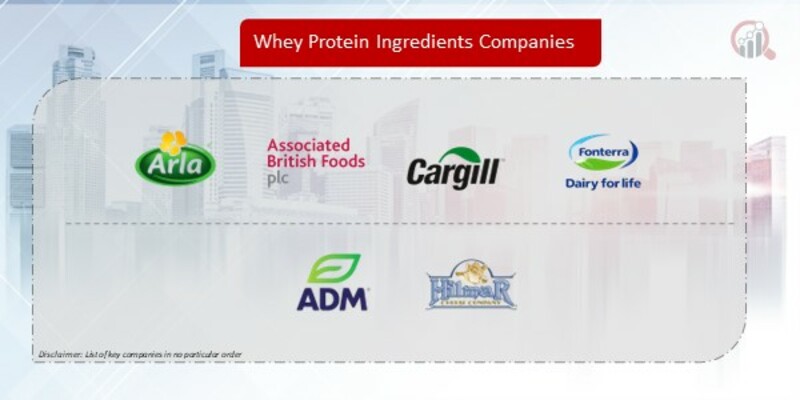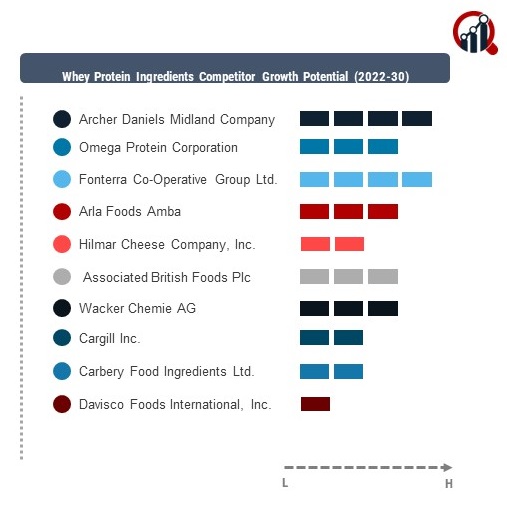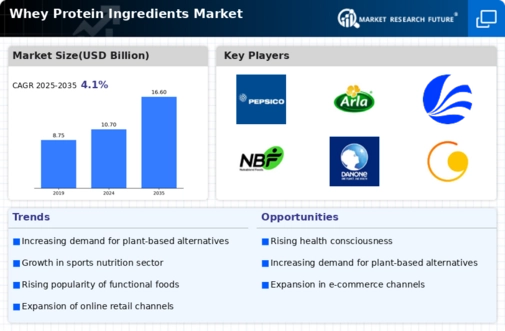Top Industry Leaders in the Whey Protein Ingredients Market

The Competitive Landscape of the Whey Protein Ingredients Market
The global whey protein ingredients market is a vital segment within the nutritional supplements and food industry, offering a high-quality protein source with diverse applications. Key players in this market strategically position themselves to address the increasing demand for protein-enriched products, capitalize on health and fitness trends, and cater to evolving consumer preferences. This analysis provides an overview of the competitive landscape, covering key players, strategies, market share factors, emerging companies, industry news, current investment trends, and a notable development in 2023.
Key Players:
Arla Foods amba (Denmark)
Hilmar Cheese Company, Inc. (US.)
Associated British Foods plc (UK)
WackerChemie AG (Germany)
Cargill Inc. (US.)
Archer Daniels Midland Company (US.)
Omega Protein Corporation (US.)
Fonterra Co-operative Group Ltd. (New Zealand)
Carbery Food Ingredients Ltd. (Ireland)
Davisco Foods International, Inc. (US.)
Strategies Adopted:
Key players in the whey protein ingredients market employ various strategies to maintain and enhance their market positions. Strategies encompass product diversification, innovation, geographical expansion, and a focus on quality and purity. For example, Arla Foods Ingredients Group P/S has been investing in research and development to create specialized whey protein ingredients for sports nutrition and clinical applications, meeting the growing demand for targeted and high-performance protein products. Such strategies help companies cater to specific consumer needs and differentiate themselves in a competitive market.
Market Share Analysis:
The whey protein ingredients market involves evaluating multiple factors impacting competitive positioning. Key considerations include protein content, quality and purity of whey protein ingredients, brand recognition, pricing strategies, distribution networks, and the ability to cater to diverse applications. Companies that effectively balance these factors are better positioned to capture and retain a significant share of the market. Additionally, factors such as compliance with industry regulations, effective marketing campaigns, and responsiveness to emerging trends, such as plant-based alternatives, contribute to market differentiation and influence consumer choices.
News & Emerging Companies:
The whey protein ingredients market has witnessed the emergence of new and innovative companies, reflecting the industry's adaptability and potential for growth. In 2023, emerging players like Nutrimed Healthcare Pvt. Ltd. entered the market with unique whey protein formulations, gaining attention for their focus on specialized dietary supplements for targeted health goals. These newcomers contribute to the market's diversity, challenging established players and fostering innovation in the whey protein ingredients sector.
Industry Trends:
The whey protein ingredients market revolve around innovation, sustainability, and addressing the demand for clean-label and naturally sourced products. Key players are investing in advanced processing technologies to enhance the functionality of whey protein, exploring sustainable sourcing practices to minimize environmental impact, and adopting transparent labeling to meet clean-label trends. Additionally, investments in marketing and promotional activities contribute to building brand awareness and increasing the adoption of whey protein ingredients across diverse consumer segments.
Current investment trends also highlight the importance of diversification and strategic partnerships. Companies are increasingly investing in partnerships with food and beverage manufacturers, sports nutrition brands, and pharmaceutical companies to co-develop whey protein-infused products. Furthermore, investments in research collaborations with academic institutions contribute to staying at the forefront of scientific advancements in protein nutrition.
Competitive Scenario:
The whey protein ingredients market is marked by robust competition among key players striving to establish themselves as leaders in this dynamic sector. Companies differentiate themselves through a combination of product innovation, quality assurance, and a keen understanding of evolving dietary preferences. The market is also influenced by factors such as global distribution networks, regulatory compliance, and the ability to adapt to changing consumer preferences, particularly in an industry where protein is a critical component of various products, from sports nutrition to infant formula.
Recent Development
The whey protein ingredients market was the acquisition of a leading whey protein isolate producer by Glanbia plc. This strategic move marked a response to the increasing demand for high-quality whey protein isolates with a focus on purity and functionality. The acquisition allowed Glanbia plc to expand its portfolio of whey protein ingredients, particularly targeting the sports nutrition and clinical nutrition segments.
Glanbia plc's strategic acquisition underscored the importance of vertical integration to ensure a robust supply chain and meet the evolving demands of key market segments. The development positioned the company as not only a global supplier of whey protein ingredients but also as a leader in providing specialized and high-performance whey protein isolates. This move not only enhanced Glanbia plc's market presence but also contributed to shaping the whey protein ingredients market by strengthening the company's position in the high-value segments of the industry.










